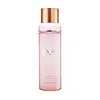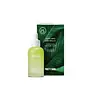What's inside
What's inside
 Key Ingredients
Key Ingredients

 Benefits
Benefits

 Concerns
Concerns

 Ingredients Side-by-side
Ingredients Side-by-side

Collagen Extract
Skin ConditioningPropanediol
SolventButylene Glycol
HumectantNiacinamide
Smoothing1,2-Hexanediol
Skin ConditioningPunica Granatum Flower Extract
Skin ConditioningCandida/Garcinia Cambogia Ferment
Zea Mays Germ Oil
EmollientActinidia Chinensis Fruit Extract
EmollientChlorella Vulgaris Extract
Skin ConditioningEel Extract
HumectantCamellia Sinensis Leaf Extract
AntimicrobialSchisandra Chinensis Callus Extract
Skin ProtectingCurcuma Longa Root Extract
MaskingHydrolyzed Collagen
EmollientUlmus Davidiana Root Extract
Skin ConditioningSodium Hyaluronate
HumectantHyaluronic Acid
HumectantHydrolyzed Hyaluronic Acid
HumectantCeteareth-12
EmulsifyingGlycerin
HumectantGlyceryl Stearate
EmollientPolyglyceryl-2 Oleate
EmulsifyingPEG-60 Hydrogenated Castor Oil
EmulsifyingCeteareth-20
CleansingCetearyl Isononanoate
EmollientCetyl Palmitate
EmollientOctyldodeceth-16
EmulsifyingEthylhexylglycerin
Skin ConditioningAdenosine
Skin ConditioningSodium Citrate
BufferingCitric Acid
BufferingSoluble Proteoglycan
Skin ConditioningHydrolyzed Sodium Hyaluronate
Skin ConditioningHydroxypropyltrimonium Hyaluronate
PEG-9 Diglycidyl Ether/Sodium Hyaluronate Crosspolymer
Skin ConditioningPotassium Hyaluronate
Skin ConditioningSodium Acetylated Hyaluronate
HumectantSodium Dna
Skin ConditioningDimethylsilanol Hyaluronate
HumectantWater
Skin ConditioningCetearyl Alcohol
EmollientDisodium EDTA
Phenoxyethanol
PreservativeSodium Benzoate
MaskingParfum
MaskingGardenia Taitensis Callus Extract
AntioxidantCollagen Extract, Propanediol, Butylene Glycol, Niacinamide, 1,2-Hexanediol, Punica Granatum Flower Extract, Candida/Garcinia Cambogia Ferment, Zea Mays Germ Oil, Actinidia Chinensis Fruit Extract, Chlorella Vulgaris Extract, Eel Extract, Camellia Sinensis Leaf Extract, Schisandra Chinensis Callus Extract, Curcuma Longa Root Extract, Hydrolyzed Collagen, Ulmus Davidiana Root Extract, Sodium Hyaluronate, Hyaluronic Acid, Hydrolyzed Hyaluronic Acid, Ceteareth-12, Glycerin, Glyceryl Stearate, Polyglyceryl-2 Oleate, PEG-60 Hydrogenated Castor Oil, Ceteareth-20, Cetearyl Isononanoate, Cetyl Palmitate, Octyldodeceth-16, Ethylhexylglycerin, Adenosine, Sodium Citrate, Citric Acid, Soluble Proteoglycan, Hydrolyzed Sodium Hyaluronate, Hydroxypropyltrimonium Hyaluronate, PEG-9 Diglycidyl Ether/Sodium Hyaluronate Crosspolymer, Potassium Hyaluronate, Sodium Acetylated Hyaluronate, Sodium Dna, Dimethylsilanol Hyaluronate, Water, Cetearyl Alcohol, Disodium EDTA, Phenoxyethanol, Sodium Benzoate, Parfum, Gardenia Taitensis Callus Extract
Water
Skin ConditioningButylene Glycol
HumectantGlycerin
HumectantPolyglycerin-3
Humectant1,2-Hexanediol
Skin ConditioningGlycereth-26
HumectantPolyglyceryl-10 Laurate
Skin ConditioningAcrylates/C10-30 Alkyl Acrylate Crosspolymer
Emulsion StabilisingPolyglyceryl-10 Myristate
Skin ConditioningArginine
MaskingGlyceryl Acrylate/Acrylic Acid Copolymer
HumectantEthylhexylglycerin
Skin ConditioningParfum
MaskingDisodium EDTA
Azulene
Skin ConditioningMelaleuca Alternifolia Leaf Extract
PerfumingRosa Damascena Flower Water
MaskingCaprylic/Capric Triglyceride
MaskingCentella Asiatica Extract
CleansingOlea Europaea Fruit Oil
MaskingHydrogenated Lecithin
EmulsifyingButyrospermum Parkii Butter
Skin ConditioningPolygonum Cuspidatum Root Extract
AntioxidantScutellaria Baicalensis Root Extract
AstringentSqualane
EmollientGlycyrrhiza Glabra Root Extract
BleachingCamellia Sinensis Leaf Extract
AntimicrobialChamomilla Recutita Flower Extract
MaskingRosmarinus Officinalis Leaf Extract
AntimicrobialCholesterol
EmollientCeramide NP
Skin ConditioningAcetylphytosphingosine
Skin ConditioningPhytosphingosine
Skin ConditioningWater, Butylene Glycol, Glycerin, Polyglycerin-3, 1,2-Hexanediol, Glycereth-26, Polyglyceryl-10 Laurate, Acrylates/C10-30 Alkyl Acrylate Crosspolymer, Polyglyceryl-10 Myristate, Arginine, Glyceryl Acrylate/Acrylic Acid Copolymer, Ethylhexylglycerin, Parfum, Disodium EDTA, Azulene, Melaleuca Alternifolia Leaf Extract, Rosa Damascena Flower Water, Caprylic/Capric Triglyceride, Centella Asiatica Extract, Olea Europaea Fruit Oil, Hydrogenated Lecithin, Butyrospermum Parkii Butter, Polygonum Cuspidatum Root Extract, Scutellaria Baicalensis Root Extract, Squalane, Glycyrrhiza Glabra Root Extract, Camellia Sinensis Leaf Extract, Chamomilla Recutita Flower Extract, Rosmarinus Officinalis Leaf Extract, Cholesterol, Ceramide NP, Acetylphytosphingosine, Phytosphingosine
Ingredients Explained
These ingredients are found in both products.
Ingredients higher up in an ingredient list are typically present in a larger amount.
1,2-Hexanediol is a synthetic liquid and another multi-functional powerhouse.
It is a:
- Humectant, drawing moisture into the skin
- Emollient, helping to soften skin
- Solvent, dispersing and stabilizing formulas
- Preservative booster, enhancing the antimicrobial activity of other preservatives
Butylene Glycol (or BG) is used within cosmetic products for a few different reasons:
Overall, Butylene Glycol is a safe and well-rounded ingredient that works well with other ingredients.
Though this ingredient works well with most skin types, some people with sensitive skin may experience a reaction such as allergic rashes, closed comedones, or itchiness.
Learn more about Butylene GlycolCamellia Sinensis Leaf Extract is derived from the leaves of the tea plant. Black tea, green tea, and oolong tea are all harvested from this plant.
This ingredient has many skin benefits:
This ingredient contains polyphenols, a strong antioxidant. Antioxidants help fight off molecules that damage skin cells.
On top of that, the antioxidants in green tea neutralize free-radicals from the sun. This gives the skin some extra UV protection, but should not replace sunscreen.
Many components of tea have anti-inflammatory properties.
Polyphenols and L-theanine help soothe the skin and reduce irritation. The caffeine in Camellia Sinensis Leaf Extract helps calm inflamed blood vessels.
Other compounds found in tea include: Vitamin Bs, linoleic acid, magnesium, calcium, iron, and zinc.
Research has shown both drinking Camellia Sinensis Leaf Tea and applying it to the skin can help boost skin elasticity and hydration. Studies also show using tea extract may reduce sebum, or oil, production.
Learn more about Camellia Sinensis Leaf ExtractDisodium EDTA plays a role in making products more stable by aiding other preservatives.
It is a chelating agent, meaning it neutralizes metal ions that may be found in a product.
Disodium EDTA is a salt of edetic acid and is found to be safe in cosmetic ingredients.
Learn more about Disodium EDTAEthylhexylglycerin (we can't pronounce this either) is commonly used as a preservative and skin softener. It is derived from glyceryl.
You might see Ethylhexylglycerin often paired with other preservatives such as phenoxyethanol. Ethylhexylglycerin has been found to increase the effectiveness of these other preservatives.
Glycerin is already naturally found in your skin. It helps moisturize and protect your skin.
A study from 2016 found glycerin to be more effective as a humectant than AHAs and hyaluronic acid.
As a humectant, it helps the skin stay hydrated by pulling moisture to your skin. The low molecular weight of glycerin allows it to pull moisture into the deeper layers of your skin.
Hydrated skin improves your skin barrier; Your skin barrier helps protect against irritants and bacteria.
Glycerin has also been found to have antimicrobial and antiviral properties. Due to these properties, glycerin is often used in wound and burn treatments.
In cosmetics, glycerin is usually derived from plants such as soybean or palm. However, it can also be sourced from animals, such as tallow or animal fat.
This ingredient is organic, colorless, odorless, and non-toxic.
Glycerin is the name for this ingredient in American English. British English uses Glycerol/Glycerine.
Learn more about GlycerinParfum is a catch-all term for an ingredient or more that is used to give a scent to products.
Also called "fragrance", this ingredient can be a blend of hundreds of chemicals or plant oils. This means every product with "fragrance" or "parfum" in the ingredients list is a different mixture.
For instance, Habanolide is a proprietary trade name for a specific aroma chemical. When used as a fragrance ingredient in cosmetics, most aroma chemicals fall under the broad labeling category of “FRAGRANCE” or “PARFUM” according to EU and US regulations.
The term 'parfum' or 'fragrance' is not regulated in many countries. In many cases, it is up to the brand to define this term.
For instance, many brands choose to label themselves as "fragrance-free" because they are not using synthetic fragrances. However, their products may still contain ingredients such as essential oils that are considered a fragrance by INCI standards.
One example is Calendula flower extract. Calendula is an essential oil that still imparts a scent or 'fragrance'.
Depending on the blend, the ingredients in the mixture can cause allergies and sensitivities on the skin. Some ingredients that are known EU allergens include linalool and citronellol.
Parfum can also be used to mask or cover an unpleasant scent.
The bottom line is: not all fragrances/parfum/ingredients are created equally. If you are worried about fragrances, we recommend taking a closer look at an ingredient. And of course, we always recommend speaking with a professional.
Learn more about ParfumWater. It's the most common cosmetic ingredient of all. You'll usually see it at the top of ingredient lists, meaning that it makes up the largest part of the product.
So why is it so popular? Water most often acts as a solvent - this means that it helps dissolve other ingredients into the formulation.
You'll also recognize water as that liquid we all need to stay alive. If you see this, drink a glass of water. Stay hydrated!
Learn more about Water